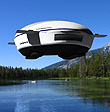A handful of aeronautics companies are developing a new generation of blimp-like hybrid airships that they hope will provide an air cargo alternative to fuel-guzzling aircraft and revive an industry undermined by the 1937 Hindenburg disaster. Utilizing advancements  in structural design, materials, and engine technology, developers say the new, more durable airships will be able to carry large loads of freight at a fraction of the cost of conventional aircraft — and require significantly less fuel. Initially, the industry will target markets where highways and airports don’t exist — including remote parts of northern Canada and China’s western frontier — before attempting to penetrate more saturated freight markets. Within two years, U.S.-based Lockheed Martin aims to introduce for commercial use its prototype SkyTug, an airship with a 20-ton payload and a range of 1,000 nautical miles, according to a report in The Daily Climate. Unlike the ill-fated Hindenburg, which carried flammable hydrogen, modern airships carry helium. “And if all the engines quit, it won’t come down like an aluminum tube,” said Gil Costin, CEO of Millennium Airship, Inc., a Washington-based firm that aims to launch a fleet of airships by 2020.
in structural design, materials, and engine technology, developers say the new, more durable airships will be able to carry large loads of freight at a fraction of the cost of conventional aircraft — and require significantly less fuel. Initially, the industry will target markets where highways and airports don’t exist — including remote parts of northern Canada and China’s western frontier — before attempting to penetrate more saturated freight markets. Within two years, U.S.-based Lockheed Martin aims to introduce for commercial use its prototype SkyTug, an airship with a 20-ton payload and a range of 1,000 nautical miles, according to a report in The Daily Climate. Unlike the ill-fated Hindenburg, which carried flammable hydrogen, modern airships carry helium. “And if all the engines quit, it won’t come down like an aluminum tube,” said Gil Costin, CEO of Millennium Airship, Inc., a Washington-based firm that aims to launch a fleet of airships by 2020.

Millennium Airship
A modern airship